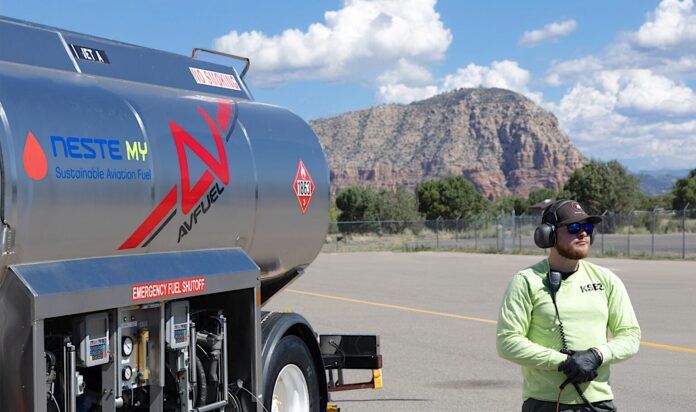Aviation fuel supplier Avfuel has joined with the Sedona-Oak Creek Airport Authority (SOCAA) and FBO Red Rock Aviation to offer sustainable aviation fuel (SAF) at the airport. This makes KSEZ Avfuel’s first SAF-capable airport in the state of Arizona. The fuel will be used to supply not only local and visiting general aviation aircraft, but also to support firefighting operations in the area.
Avfuel has been Red Rock Aviation’s fuel supplier since 2022. The first 8,000-gallon truckload of SAF, produced by Long Beach, California-based Neste, arrived at KSEZ on June 5. Plans call for SAF jet fuel deliveries for every 10th shipment—about one every two months. Each truckload of fuel is calculated to reduce carbon emissions by 19 metric tons, or the equivalent of taking 4.5 passenger cars off the road for one year.
SOCAA airport manager Ed Rose said, “We are excited to incorporate SAF into our growing list of sustainability initiatives. SAF is a safe, proven and sustainable blend of jet fuel that will help the Sedona Airport be a good neighbor and do its part to reduce the overall production of greenhouse gasses.”





































Reduce by 19 metric tons per truckload?
Wow, now the trucks can carry an extra 41,887 of fuel on every delivery! Good news for that remote location.
Fun math. Multiply the weight of non fossil carbon in the fuel by 3.7 for the weight of net emissions avoided. Of course burning the fuel emits the same amount as any fuel, but the carbon source was more recently captured from the atmosphere rather than coming from a fossil source, so it doesn’t increase the co2 concentration in the atmosphere. I hope the fuel really is equivalent in performance, Sedona would not be a good place to have a power interruption.
Interesting coincidence–two fuel-related stories on the same page.
“Plans call for SAF jet fuel deliveries for every 10th shipment—about one every two months.”
Also on the same page–the continuing non-story about GAMI fuel being “unapproved”–though the FAA has approved it in every piston aviation airplane that burns 100LL.
SAF fuel in jets is embraced by the “politically correct” because it is perceived as an “environmental fuel”–(though nothing is said about “USING energy to MAKE energy”). Never mind that only 10% of the fuel at that airport is SAF–and it isn’t widely distributed.
By comparison, GAMI fuel can be distributed widely and easily.
The two articles appear on AvWeb right next to each other. This appears to be “management by press release and innuendo”–Like GAMI fuel, SAF may be used in place of the fuel specified in the original certification. Why the difference?
AvWeb should point out this difference between the way alternative fuels have been handled–and ask the would-be regulators “why the difference?”
The physics and technicalities behind turbine combustion and piston combustion are vastly different. Turbine engines have a very broad range of fuel compatibility whereas pistons, especially high performance pistons, are critically narrow and specific.
Regarding Jim’s question “why the difference?”; SAF jet fuel is essentially the identical formulation as existing with the only difference being the source of the hydrocarbons – old hydrocarbons (petroleum) or young hydrocarbons (spent cooking oils, etc). The challenge with UL100 is that new formulations with different ingredients need to be created in order to replicate the octane level and detonation suppression (among other things) afforded by TEL in our current fuel. The new ingredients in the formulation are concerning as to the possible degrading effects on the wide variety of materials in use in our aircraft: seals, hoses, metals, etc. under a wide variety of compressions, temperatures and use cases. No one questions why we cannot use fuel with alcohol in our aircraft; we should be equally concerned about any other new additive in our fuel – especially if the manufacturer is loathe to disclose the recipe.
You guys are waaaaay too factual – almost logical, in your comments. Thats a NOGO. Its probably safer to just blame DEI, women owned fuel manufacturers who get preferred treatment in the widely marxist…. (you get my drift). Cirrus is probably owned by activist women who wish to take over the planet.
Inserting too many facts into comments causes anxiety and profound insecurities. Please don’t. Stay the course!
😂
Piston and Jet Engines don’t have “Carbon” emissions. The emit carbon dioxide (CO2) which is as similar to carbon as water is to hydrogen. What the climate apocalypse cult don’t talk about much is without CO2 no life on earth would exists, zero, nada, ziltch.
CO2 is .04% of the atmosphere, or 420 parts per MILLION and the whole greenhouse effect computer models that show CO2 as a “greenhouse gas” leave out the effects of clouds on the climate because, wait for it, they can’t predict cloud formation!
Clouds and their movements have a far more profound effect on climate and weather than the trace gas CO2, in fact the increasing carbon dioxide is causing more greening of the earth and increased farm productions.
So go fly your airplane, drive your car and live life because you are probably helping the environment!
Clear prop!
The Federal Government is preventing me from having 91-96 UNLEADED AvGas at my airport for the last 40 years. At this point all I can do is point the finger at government as the reason I have to use lead.